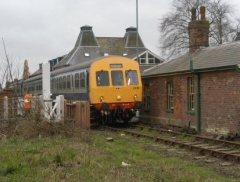Metro-Cammell DMU
From PikkaWiki
(Difference between revisions)
m (PikkaWiki moved page Metro Cammell DMU to Metro-Cammell DMU) |
|||
| (3 intermediate revisions by one user not shown) | |||
| Line 6: | Line 6: | ||
|- | |- | ||
!|Type: | !|Type: | ||
| − | |Diesel | + | |Diesel Multiple Unit |
|- | |- | ||
!|Introduction: | !|Introduction: | ||
| Line 18: | Line 18: | ||
|- | |- | ||
!|Power: | !|Power: | ||
| − | | | + | |600hp |
|- | |- | ||
!|Weight: | !|Weight: | ||
| − | | | + | |64t |
|- | |- | ||
!|Tractive Effort: | !|Tractive Effort: | ||
| − | | | + | |80kN |
|- | |- | ||
!|Capacity: | !|Capacity: | ||
| − | | | + | |50 passengers; refittable to any express cargo. |
|- | |- | ||
!|Replaces: | !|Replaces: | ||
| Line 37: | Line 37: | ||
==Special GRF features== | ==Special GRF features== | ||
| − | * | + | *Dual-headed DMU. |
| + | *Can only haul [[Passenger Cars|Standard Carriages]] and Mail Carriages. | ||
==Prototype information== | ==Prototype information== | ||
Latest revision as of 15:08, 30 May 2018
The Metro Cammell DMU is a diesel locomotive in the UK Railway Set.
[edit] Statistics and information
| Type: | Diesel Multiple Unit |
|---|---|
| Introduction: | 1955 |
| Withdrawal: | 2000 |
| Speed: | 70mph |
| Power: | 600hp |
| Weight: | 64t |
| Tractive Effort: | 80kN |
| Capacity: | 50 passengers; refittable to any express cargo. |
| Replaces: | AEC Railcar, AEC Railbus, Pannier, Suburban |
| Replaced By: | Sprinter, Express Sprinter |
[edit] Special GRF features
- Dual-headed DMU.
- Can only haul Standard Carriages and Mail Carriages.
[edit] Prototype information
"Newfangled" DMUs made a big change to the railway scene from the mid 1950s. Replacing steam-hauled trains and older railbusses, their low running costs made many less-trafficked lines viable again, and their decent top speed allowed them to mix with traffic on the main line too.[edit] Similar locomotives
The model in PJ1K is a Class 101, the first and best-known of the early DMUs, but it can stand for any of the first-generation units.

